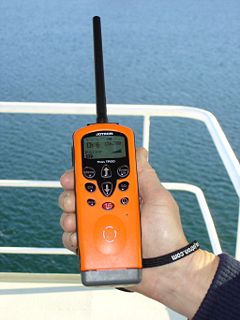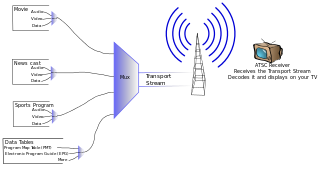Related Research Articles
Routing is the process of selecting a path for traffic in a network or between or across multiple networks. Broadly, routing is performed in many types of networks, including circuit-switched networks, such as the public switched telephone network (PSTN), and computer networks, such as the Internet.
A network switch is networking hardware that connects devices on a computer network by using packet switching to receive and forward data to the destination device.

Telemetry is the collection of measurements or other data at remote or inaccessible points and their automatic transmission to receiving equipment for monitoring. The word is derived from Greek the roots tele, "remote", and metron, "measure". Systems that need external instructions and data to operate require the counterpart of telemetry, telecommand.

An intelligent transportation system (ITS) is an advanced application which aims to provide innovative services relating to different modes of transport and traffic management and enable users to be better informed and make safer, more coordinated, and 'smarter' use of transport networks.

Wireless communication is the transfer of information or power between two or more points that are not connected by an electrical conductor. The most common wireless technologies use radio waves. With radio waves distances can be short, such as a few meters for Bluetooth or as far as millions of kilometers for deep-space radio communications. It encompasses various types of fixed, mobile, and portable applications, including two-way radios, cellular telephones, personal digital assistants (PDAs), and wireless networking. Other examples of applications of radio wireless technology include GPS units, garage door openers, wireless computer mouse, keyboards and headsets, headphones, radio receivers, satellite television, broadcast television and cordless telephones. Somewhat less common methods of achieving wireless communications include the use of other electromagnetic wireless technologies, such as light, magnetic, or electric fields or the use of sound.

ZigBee is an IEEE 802.15.4-based specification for a suite of high-level communication protocols used to create personal area networks with small, low-power digital radios, such as for home automation, medical device data collection, and other low-power low-bandwidth needs, designed for small scale projects which need wireless connection. Hence, ZigBee is a low-power, low data rate, and close proximity wireless ad hoc network.
Radio Data System (RDS) is a communications protocol standard for embedding small amounts of digital information in conventional FM radio broadcasts. RDS standardizes several types of information transmitted, including time, station identification and program information.

DirectBand was a North American wireless datacast network owned and operated by Microsoft. It used FM radio broadcasts in over 100 cities to constantly transmit data to a variety of devices, including portable GPS devices, wristwatches and home weather stations.

Near-field communication (NFC) is a set of communication protocols that enable two electronic devices, one of which is usually a portable device such as a smartphone, to establish communication by bringing them within 4 cm of each other.

Traffic Message Channel (TMC) is a technology for delivering traffic and travel information to motor vehicle drivers. It is digitally coded using the ALERT C or TPEG protocol into RDS Type 8A groups carried via conventional FM radio broadcasts. It can also be transmitted on Digital Audio Broadcasting or satellite radio. TMC allows silent delivery of dynamic information suitable for reproduction or display in the user's language without interrupting audio broadcast services. Both public and commercial services are operational in many countries. When data is integrated directly into a navigation system, traffic information can be used in the system's route calculation.
Datacasting is the broadcasting of data over a wide area via radio waves. It most often refers to supplemental information sent by television stations along with digital terrestrial television, but may also be applied to digital signals on analog TV or radio. It generally does not apply to data which is inherent to the medium, such as PSIP data which defines virtual channels for DTT or direct broadcast satellite systems; or to things like cable modem or satellite modem, which use a completely separate channel for data.

The Program and System Information Protocol (PSIP) is the MPEG and privately defined program-specific information originally defined by General Instrument for the DigiCipher 2 system and later extended for the ATSC digital television system for carrying metadata about each channel in the broadcast MPEG transport stream of a television station and for publishing information about television programs so that viewers can select what to watch by title and description. Its FM radio equivalent is Radio Data System (RDS).

The automatic identification system (AIS) is an automatic tracking system that uses transponders on ships and is used by vessel traffic services (VTS). When satellites are used to detect AIS signatures, the term Satellite-AIS (S-AIS) is used. AIS information supplements marine radar, which continues to be the primary method of collision avoidance for water transport.

A computer network is a digital telecommunications network which allows nodes to share resources. In computer networks, computing devices exchange data with each other using connections between nodes. These data links are established over cable media such as twisted pair or fiber-optic cables, and wireless media such as Wi-Fi.
The Integrated Transport Information System (ITIS) is a traffic management system in Klang Valley, Malaysia. The system began operation on 2005 with the cooperation of Kuala Lumpur City Hall (DBKL), Malaysian Highway Authority, Malaysian Public Works Department (JKR) and the Ministry of Transport Malaysia. The system is used for traffic monitoring, accident, construction and other situations that happen on the roads and highways in Kuala Lumpur and Klang Valley. The main ITIS headquarters and traffic operation centre is located at Bukit Jalil Highway near Technology Park Malaysia in Bukit Jalil.

Traffic reporting is the near real-time distribution of information about road conditions such as traffic congestion, detours, and traffic collisions. The reports help drivers anticipate and avoid traffic problems. Traffic reports, especially in cities, may also report on major delays to mass transit that does not necessarily involve roads. In addition to periodic broadcast reports, traffic information can be transmitted to GPS units, smartphones, and personal computers.
CEN ISO/IEEE 11073 Health informatics - Medical / health device communication standards enable communication between medical, health care and wellness devices and with external computer systems. They provide automatic and detailed electronic data capture of client-related and vital signs information, and of device operational data.
Ford Sync is a factory-installed, integrated in-vehicle communications and entertainment system that allows users to make hands-free telephone calls, control music and perform other functions with the use of voice commands. The system consists of applications and user interfaces developed by Ford and other third-party developers. The first two generations run on the Windows Embedded Automotive operating system designed by Microsoft, while the third generation currently runs on the QNX operating system from BlackBerry Limited.

EchoStar Mobile was set up in 2008 as Solaris Mobile, a joint venture company between SES and Eutelsat Communications to develop and commercialize the first geostationary satellite systems in Europe for broadcasting video, radio and data to in-vehicle receivers and to mobile devices, such as mobile phones, portable media players and PDAs. In January 2014 all stock in Solaris Mobile was acquired by EchoStar Corporation and in March 2015 the company was renamed EchoStar Mobile.

Toyota Entune is an integrated multimedia navigation and telematics system for Toyota automobiles, providing satellite-based information on traffic, weather, sports scores, stocks, and fuel prices via subscription through SiriusXM. When connected to a compatible cellular phone running the Entune app, via radio or USB cable, the system provides a browser and other apps, including those from music services such as iHeartRadio, Pandora and XM Satellite Radio. The cell phone app has iOS, Android, and Blackberry versions; to use this feature, a cell phone data plan is required. The system can be controlled with voice recognition, and may include the “Safety Connect” personalization system.